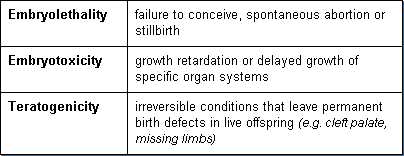|
 |
 |
 |
 |
|
|
|






Systemic Toxic Effects

Toxic effects are generally categorized according to the site of the toxic effect. In some cases, the effect may occur at only one site. This site is referred to as the specific target organ. In other cases, toxic effects may occur at multiple sites. This is referred as systemic toxicity. Following are types of systemic toxicity:
 |
 |
 |
|  | Acute Toxicity
|
 |
|  | Subchronic Toxicity
|
 |
|  | Chronic Toxicity
|
 |
|  | Carcinogenicity
|
 |
|  | Developmental Toxicity
|
 |
|  | Genetic Toxicity (somatic cells)
|
 |
Acute Toxicity

Acute toxicity occurs almost immediately (hours/days) after an exposure. An acute exposure is usually a single dose or a series of doses received within a 24 hour period. Death is a major concern in cases of acute exposures. Examples are:
 |
 |
 |
|  | In 1989, 5,000 people died and 30,000 were permanently disabled due to exposure to methyl isocyanate from an industrial accident in India.
|
 |
|  | Many people die each year from inhaling carbon monoxide from faulty heaters.
|
 |
Non-lethal acute effects may also occur, e.g., convulsions and respiratory irritation.
Subchronic Toxicity

Subchronic toxicity results from repeated exposure for several weeks or months. This is a common human exposure pattern for some pharmaceuticals and environmental agents. Examples are:
 |
 |
 |
|  | Ingestion of coumadin tablets (blood thinners) for several weeks as a treatment for venous thrombosis can cause internal bleeding.
|
 |
|  | Workplace exposure to lead over a period of several weeks can result in anemia.
|
 |
Chronic Toxicity

Chronic toxicity represents cumulative damage to specific organ systems and takes many months or years to become a recognizable clinical disease. Damage due to subclinical individual exposures may go unnoticed. With repeated exposures or long-term continual exposure, the damage from these subclinical exposures slowly builds-up (cumulative damage) until the damage exceeds the threshold for chronic toxicity. Ultimately, the damage becomes so severe that the organ can no longer function normally and a variety of chronic toxic effects may result.
Examples of chronic toxic affects are:
 |
 |
 |
|  | cirrhosis in alcoholics who have ingested ethanol for several years
|
 |
|  | chronic kidney disease in workmen with several years exposure to lead
|
 |
|  | chronic bronchitis in long-term cigarette smokers
|
 |
|  |
pulmonary fibrosis in coal miners (black lung disease)
|
 |
Carcinogenicity

Carcinogenicity is a complex multistage process of abnormal cell growth and differentiation which can lead to cancer. At least two stages are recognized. They are initiation in which a normal cell undergoes irreversible changes and promotion in which initiated cells are stimulated to progress to cancer. Chemicals can act as initiators or promoters.
The initial neoplastic transformation results from the mutation of the cellular genes that control normal cell functions. The mutation may lead to abnormal cell growth. It may involve loss of suppresser genes that usually restrict abnormal cell growth. Many other factors are involved (e.g., growth factors, immune suppression, and hormones).
A tumor (neoplasm) is simply an uncontrolled growth of cells. Benign tumors grow at the site of origin; do not invade adjacent tissues or metastasize; and generally are treatable. Malignant tumors (cancer) invade adjacent tissues or migrate to distant sites (metastasis). They are more difficult to treat and often cause death.
Developmental Toxicity

Developmental Toxicity pertains to adverse toxic effects to the developing embryo or fetus. This can result from toxicant exposure to either parent before conception or to the mother and her developing embryo-fetus. The three basic types of developmental toxicity are:

Chemicals cause developmental toxicity by two methods. They can act directly on cells of the embryo causing cell death or cell damage, leading to abnormal organ development. A chemical might also induce a mutation in a parent's germ cell which is transmitted to the fertilized ovum. Some mutated fertilized ova develop into abnormal embryos.
Genetic Toxicity

Genetic Toxicity results from damage to DNA and altered genetic expression. This process is known as mutagenesis. The genetic change is referred to as a mutation and the agent causing the change as a mutagen. There are three types of genetic change:

If the mutation occurs in a germ cell the effect is heritable. There is no effect on the exposed person; rather the effect is passed on to future generations. If the mutation occurs in a somatic cell, it can cause altered cell growth (e.g. cancer) or cell death (e.g. teratogenesis) in the exposed person.

  
|
|
|
|